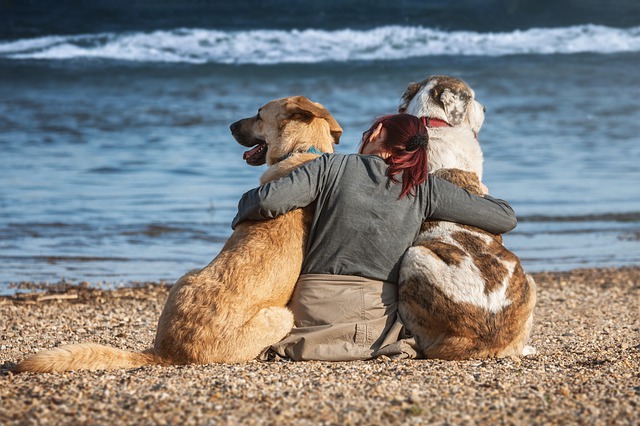Summer is finally here and it feels like it’s going to be a hot one! While we hope that you’ll be having lots of fun this summer, don’t forget that your furry friends may not be as prepared for a scorcher as you are
Summer is finally here and it feels like it’s going to be a hot one! While we hope that you’ll be having lots of fun this summer, don’t forget that your furry friends may not be as prepared for a scorcher as you are. With temperatures climbing higher every day, you should already be thinking about how to prepare for summer this year. So follow our top 5 tips to keep your pet safe this summer.
1) Keeping Cool at Home
Everyone knows it is important to keep cool in summer, and the same is true for pets. As well as reducing the chance of getting heatstroke (more on this later), ensuring your pets are cool will increase their general comfort in the stifling sun.
Water is essential, so ensure your pets’ water bowls are always topped up with fresh, cool water. Don’t forget to fill the water bottles of your small pets, like rabbits and hamsters too. Make sure there is plenty of shade if your pets lie out in the garden. If there isn’t any, provide some with a parasol or similar, or just restrict them going outside during the hotter parts of the day (usually a few hours either side of midday). Again remembering your small furries, keep their cages well away from strong sunlight, in a cooler part of the house. If you have a long-haired breed of pet, consider getting them groomed short (if the breed is suitable for this) to help cool them down.
Some more outlandish, but definitely effective ways of keeping pets cool might be to freeze some kibble or chews in a little water, creating your own pet popsicles, which are both tasty and cooling! Paddling pools can also be great for hot dogs to cool off in when you’re out in the garden. And for cats who probably won’t appreciate the cold bath (or maybe yours will!), or for any other dogs, a towel soaked in cold water or straight from the fridge can be the perfect blanket to cool warm bodies.
2) Recognising Heatstroke
If you follow the tips above, you will make it much less likely for your pet to have heatstroke, as well as be much more comfy. However, even with the best of care, heatstroke can occur, and it is important you recognise what heatstroke is, and what you should do if you suspect your pet may have it.
Heatstroke is where an animal’s (or person’s) body is unable to regulate its internal temperature, which gets dangerously high. The body can only tolerate minor increases in temperature, so a very hot animal’s cells will start to become damaged, leading to widespread problems. It is usually caused by a combination of high external temperatures (summer of course being the hottest) and excessive physical exercise. As a result, dogs running around on hot days are most at risk. Rabbits are also quite commonly heatstruck. However, all animals can be affected.
So what are the signs? Be on the lookout for heavy panting, darker than normal gums, tiredness, vomiting, and diarrhoea. These signs can progress to collapse and seizures. In extreme cases, heatstroke can unfortunately be fatal.
If you spot a combination of these signs, and suspect heatstroke, immediately take your animal indoors or into shade. Give them room temperature water to drink, and gently cool them down by wetting their fur. You should also contact us immediately, so we can give guidance on what to do next.
3) Travel Tips
Now that you know a little more about keeping your animals cool, and making sure they do not get heatstroke, you’re ready to spend time in the glorious British summer. Perhaps you might want to take a trip to the beach, or even abroad with your pooch (or pussy cat!). Before you hit the road, we’ve got some travel tips you might want to follow.
In the UK, all pets travelling in a car must be restrained properly. If they are in a carrier or cage, this must be secured so it cannot move; consider also padding the inside, to prevent the animal being thrown about. Larger dogs which don’t fit in cages still need securing – there are doggy seatbelts available which will do the job, for your safety and theirs.
While travelling, make sure to take regular breaks. If you need a rest-stop, your furry friend probably does too! Get out and stretch all four legs when you can. Ensure there is plenty of water to drink, and keep the air-conditioning on. We hope by now owners are more aware of this problem, but to reiterate, never leave an animal alone in a parked car – while parked, cars act like greenhouses, and temperatures can get fatally high. Don’t take the chance and leave them.
It might also be a good idea to have a travel kit with you, including water bottles, food, poo bags, any medication, a lead, and treats, just in case you want to make a spontaneous trip together!
4) Out and About
Whether near or far, most dogs and cats will want to spend some time outside your garden, where it might be harder to keep them cool.
For dogs, you can try and walk them only in the morning or evening. This will be much cooler and crucially, the pavements will not be as hot – pavements get very hot in summer, and your dog’s sensitive paws will suffer. As a general rule, if you cannot keep the back of your hand on the pavement for more than five seconds, it is too hot for your dog. If you absolutely have to go out during this time, consider some protective covers on their feet. And at all times in summer, try not to let them exert themselves too much, as this is a common cause of heatstroke. Finally, though it might not be the most effective way of keeping cool, a special doggy sunhat can help, not to mention make them look adorable!
Cats are trickier, as most will not take kindly to a lead! On the whole, cats are better at managing their temperature, and do not exert themselves as much as dogs. However, one risk to cats is sunburnt ears; white-haired breeds are especially vulnerable. You can buy special cat sun cream which will protect them – just pop a little on their ear tips for protection before they go out.
5) Summer Parasites
Summer is a time when lots of animals spend time in the sun, and this unfortunately extends to a number of horrible little critters too – many parasites are more common in summer, and it is important to be aware of them.
Mainly applying to rabbit owners (though all pet owners should be aware), flies multiply like rabbits (!) in summer. While they themselves are only a minor nuisance, flies like to lay eggs on dirty, matted or damaged skin and fur – in rabbits, this is commonly their back ends. When the eggs hatch, the larvae start to eat the damaged skin, causing inflammation and pain. This condition is called flystrike. If you own rabbits, ensure they keep clean and be on the lookout for any maggots around their bottoms.
A parasite affecting all animals, ticks are little bloodsucking arachnids that hide in long grass and love to latch onto your pet’s skin. Usually only one or two will jump on, which is not a huge issue in itself – however, ticks will often spread diseases, like Lyme disease, when they drink the blood of different animals. If you spot a tick, remove it as soon as you can, or pop in so we can safely remove it. Don’t forget humans can catch them too, so be careful when walking through long grass with short baggy clothes on!
As a final note, we also would like to remind you not to forget your pet’s normal flea and worming treatment. With more flying insects around, this can be especially important, and the last thing you want is a nasty parasite infection ruining your holiday!
Final Thoughts
Summer can be great fun, and we’re sure you and your best friends are looking forward to it as much as we are. But as always, safety should come first, so make sure to remember our top 5 tips on summer safety so your pet doesn’t have to have an unplanned visit to us! Stay safe, have fun, and enjoy the

